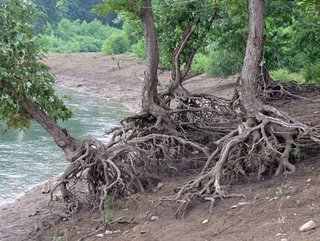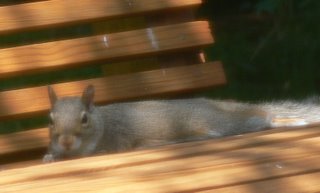 My husband volunteers at Bernheim Forest near Louisville, and relishes his time spent there, as I do my time at the Falls of the Ohio. Sunday, several of the volunteers went on a hike, and I decided to join them. I should have realized I was in over my head when the group consisted of five men in jeans, hiking boots, and backpacks, carrying walking sticks. I, on the other hand, wore shorts, sneakers, binoculars and camera, and a fanny pack. The leader said we would loop around and should be back in about three hours. OK, I thought, I should be able to do that, and off we went.
We walked down overgrown fire roads through the forest and down into the creek bed. The men were all very knowledgeable about the Forest and all things in it. We noticed small things like oak galls and brightly colored mushrooms against the leaves on the forest floor. Tiny spiders tried to catch us in their webs across the trail. I was glad to let the men take the point. As we descended from the ridge top, we noticed the change in trees from oaks, primarily, to beech and maple, then sycamores.
My husband volunteers at Bernheim Forest near Louisville, and relishes his time spent there, as I do my time at the Falls of the Ohio. Sunday, several of the volunteers went on a hike, and I decided to join them. I should have realized I was in over my head when the group consisted of five men in jeans, hiking boots, and backpacks, carrying walking sticks. I, on the other hand, wore shorts, sneakers, binoculars and camera, and a fanny pack. The leader said we would loop around and should be back in about three hours. OK, I thought, I should be able to do that, and off we went.
We walked down overgrown fire roads through the forest and down into the creek bed. The men were all very knowledgeable about the Forest and all things in it. We noticed small things like oak galls and brightly colored mushrooms against the leaves on the forest floor. Tiny spiders tried to catch us in their webs across the trail. I was glad to let the men take the point. As we descended from the ridge top, we noticed the change in trees from oaks, primarily, to beech and maple, then sycamores.
 The stones of the creek were smooth, damp and slippery. Again, we found small toads, skinks, and delicate mosses and worts growing green in the dampness. Although there was little water that day, you could tell from the leaves caught in the high tree branches that floods would quickly fill the entire valley when it stormed. With some searching, we found three of the elusive Cardinal flowers. The sides of the creek valley were lined in limestone cliffs, worn and crevassed with the passage of time and water. At times, huge boulders had fallen to the bottom, and or there were gaps between the cliffs for explorers and deer to descend to the water. A peculiar kind of rock with vertical markings was some sort of petrified wood or plant, they said. I took some samples for our geologist to examine.
Around a bend, the road moved towards several large fields that had been recently mowed. Was the large pile of bird feathers the remains of some raptors' breakfast, or had a bird been caught by the bush hog and cut to pieces? A turtle shell with a hole looked like it was victim to the dreaded bush hog. The field, however, held the greatest wealth and variety of life, with butterflies and other insects, wildflowers and small trees and shrubs with ripening berries. One of our hikers was delighted to finally see the actual berries on a hackberry tree for the first time. We saw an insect that was about the size and shape of a wasp, a black abdomen with white stripes, and wings the most iridescent navy blue I've ever seen. Of course, by the time I got the camera focused, it flew away, but some of the butterflies were much more co-operative.
The stones of the creek were smooth, damp and slippery. Again, we found small toads, skinks, and delicate mosses and worts growing green in the dampness. Although there was little water that day, you could tell from the leaves caught in the high tree branches that floods would quickly fill the entire valley when it stormed. With some searching, we found three of the elusive Cardinal flowers. The sides of the creek valley were lined in limestone cliffs, worn and crevassed with the passage of time and water. At times, huge boulders had fallen to the bottom, and or there were gaps between the cliffs for explorers and deer to descend to the water. A peculiar kind of rock with vertical markings was some sort of petrified wood or plant, they said. I took some samples for our geologist to examine.
Around a bend, the road moved towards several large fields that had been recently mowed. Was the large pile of bird feathers the remains of some raptors' breakfast, or had a bird been caught by the bush hog and cut to pieces? A turtle shell with a hole looked like it was victim to the dreaded bush hog. The field, however, held the greatest wealth and variety of life, with butterflies and other insects, wildflowers and small trees and shrubs with ripening berries. One of our hikers was delighted to finally see the actual berries on a hackberry tree for the first time. We saw an insect that was about the size and shape of a wasp, a black abdomen with white stripes, and wings the most iridescent navy blue I've ever seen. Of course, by the time I got the camera focused, it flew away, but some of the butterflies were much more co-operative.
 Then reality struck. Not rain, although the barrage of ordnance from nearby Fort Knox sounded like thunder all morning, but distance was the enemy. We had spent our three hours, and the leader announced that from this point it was another two miles or more, UPHILL, back to our cars. Not only that, but the fire road we took was in excellent condition with lots of sharp gravel to poke holes into my aching feet. We had taken a bug spray break earlier in the woods, but were unprepared for the bugs of the field -- chiggers and something that didn't show up until two days later, when both of us developed itchy, almost rash-like bumps all over legs and feet, and even under our shoes which should not have been exposed at all!
Living in "civilization", we are happy to return to nature, and enjoy its beauties, but we forget the uncomfortable sides of nature. I thought how it must have been for the pioneers, trudging through the forest, without a mowed fire road to follow. Climbing up each hill and sliding down each valley, without a plastic bottle of water to drink from, or a granola bar for energy. We might have gotten turned around sometimes, but at the top of the hill, we could still call the visitor's center on a cell phone. The pioneers had only themselves to depend on. And they had no bug spray at all....
Then reality struck. Not rain, although the barrage of ordnance from nearby Fort Knox sounded like thunder all morning, but distance was the enemy. We had spent our three hours, and the leader announced that from this point it was another two miles or more, UPHILL, back to our cars. Not only that, but the fire road we took was in excellent condition with lots of sharp gravel to poke holes into my aching feet. We had taken a bug spray break earlier in the woods, but were unprepared for the bugs of the field -- chiggers and something that didn't show up until two days later, when both of us developed itchy, almost rash-like bumps all over legs and feet, and even under our shoes which should not have been exposed at all!
Living in "civilization", we are happy to return to nature, and enjoy its beauties, but we forget the uncomfortable sides of nature. I thought how it must have been for the pioneers, trudging through the forest, without a mowed fire road to follow. Climbing up each hill and sliding down each valley, without a plastic bottle of water to drink from, or a granola bar for energy. We might have gotten turned around sometimes, but at the top of the hill, we could still call the visitor's center on a cell phone. The pioneers had only themselves to depend on. And they had no bug spray at all....




